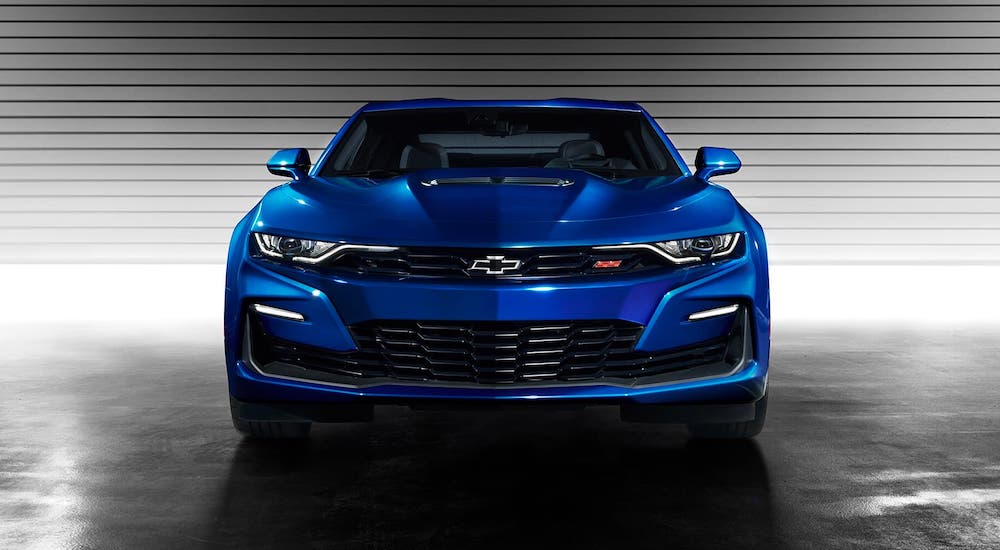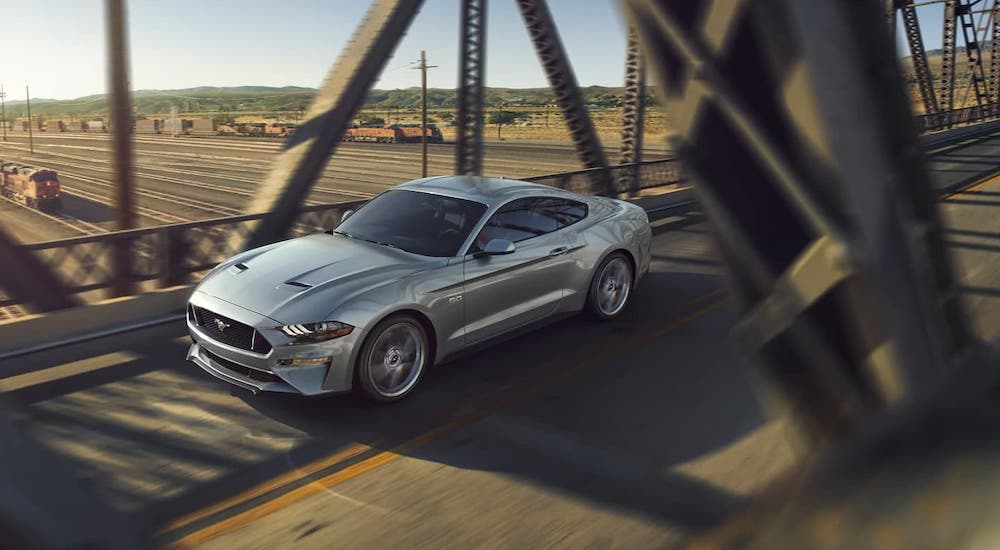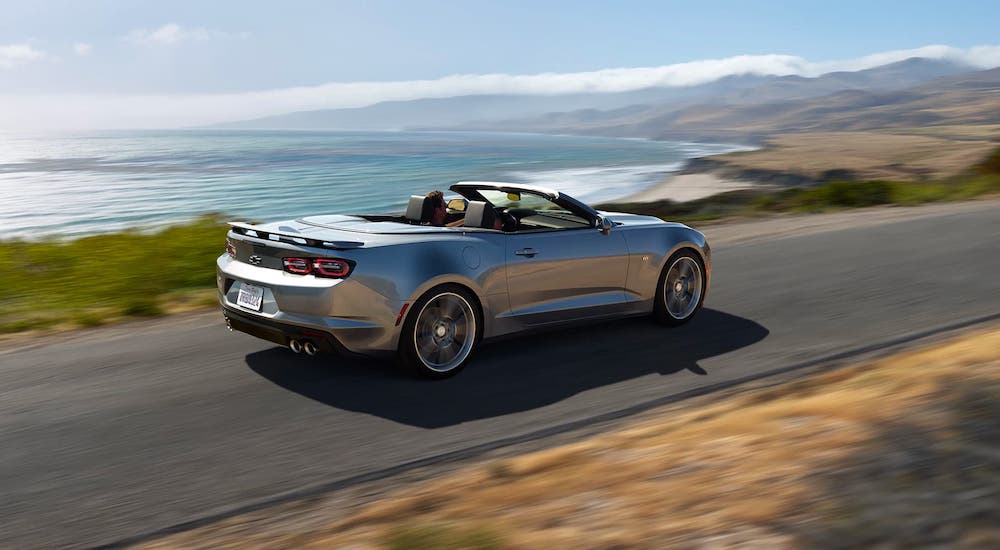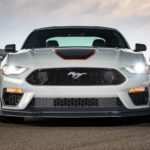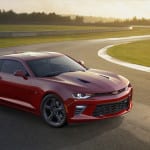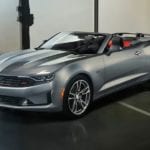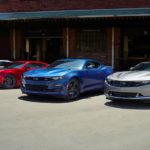American muscle cars are cultural icons. Today’s models have legacies going back to the 1960s, giving them huge nostalgia value on top of good looks, great sound, and thrilling performance. This is not the market for drivers looking to shuttle a family around town or haul a camper deep into the woods. “Pony cars” are far from practical, but practicality isn’t what they’re all about. They’re about driving as a passion. Two of the best offerings in this category deliver a low starting price, lofty performance peaks, and wicked styling appropriate for their segment, so to highlight this classic American product, we’re going to break down the 2021 Chevy Camaro vs 2021 Ford Mustang in a head to head comparison.
The Mustang is the car that started it all with its surprise announcement in 1964, and its instant success outperformed Ford’s expectations almost seven times over. The first decade of Mustang production was all about bigger engines and cooler looks than anything else on the market. Though it changed radically over the decades to keep up with changing priorities, production has never been interrupted, and since 2005 the styling has hearkened back to the then-40-year-old classic that captured the hearts and minds of millions.
When Ford dropped the Mustang bomb on the auto industry, General Motors was quick to answer with the Camaro. The 1966 Camaro sold about half as many units as Mustang, not bad for a newcomer, and has been Ford’s greatest rival ever since. A hot-rodding favorite for decades, it made good sense that when it was reintroduced in 2010 after an 8-year absence, its wide, aggressive looks recalled the Camaros of old. Now that look has evolved into something more angular and futuristic than the segment has ever seen, visually representing an emphasis on advancing all aspects of the Camaro experience.
Today the Mustang and Camaro compete as fiercely as they did 50 years ago in the pony car’s heyday. Both offer a tremendous range of trims and packages to suit buyers of all tastes and budgets. Mustang makes a better case as a daily driver, with better outward visibility and nearly-practical trunk volume. However, the high-power muscle car class is all about the driving experience––and we think nothing delivers that experience like Camaro.
Where to Start?
This segment is known for offering highly-affordable base models at a third of the cost of heavily-tuned performance versions. We think there’s no better place to start a comparison than with those bare-bones entry-level models.
For the 2021 Chevy Camaro, that’s a coupe-bodied 1LS with a standard 2.0L turbocharged 4-cylinder engine and 6-speed manual transmission. It’s an impressive powertrain that produces up to 275 hp and 295 lb-ft of torque with an EPA rating of 20/30 (city/highway) MPG. Despite the low price, the base Camaro still has three drive modes and a limited-slip differential on the RWD system. Chevy’s Infotainment 3 system is delivered through a 7” touchscreen with fantastic connectivity options––4G Wi-Fi hotspot capability and wireless Apple CarPlay/Android Auto compatibility are standard. An 8-way power-adjustable driver’s seat and power recline passenger seat form a nice baseline in comfort as well.
Prospective buyers with kids will also appreciate that Teen Driver is standard––if there’s any chance your student driver would get behind the wheel of your Camaro. You can use this feature to set limits on how the car will behave and monitor your teen’s driving habits even if you’re not in the car with them.
Ford hasn’t yet released the build tool for the 2021 Mustang, but changes from 2020 are known and few. Chief among these is that the Ford Co-Pilot360 safety tech suite will be standard. While this will surely increase the base 2020 Ford Mustang EcoBoost Fastback’s MSRP of $26,670, the extra money is going to good use. As implied in the name, the base Mustang sports a 2.3L EcoBoost 4-cylinder engine that makes 310 hp and 350 lb-ft of torque with its own 6-speed manual and 21/32 (city/highway) MPG EPA ratings. However, Car and Driver reported a fuel efficiency rating that was 7 MPG worse than EPA estimates for the 2020 version of this car.
Base 2020 Mustang owners only get the basic SYNC infotainment system with a small infotainment screen and no Apple/Android integration options (SYNC 3 with a larger screen and smartphone integration is available through a package). The front seats are more rigid, with 4-way and 2-way manual adjustments for driver and passengers, respectively. Despite the low-tech baseline for connectivity and comfort, however, the 2021 Mustang reportedly includes the Ford Co-Pilot360 driver assistance suite standard. That would mean the EcoBoost Fastback will have a blind spot monitor, lane monitor, forward collision alerts, and automatic emergency braking, features inaccessible to the Camaro in base 1LS trim.
From Clark Kent to Superman in a Flash
While base model Camaros and Mustangs certainly fit most budgets, it’s the top-performing high trim models that get the most attention. With exterior tweaks to enhance performance, they look meaner, and there’s no mistaking the roar of their V8 engines. Any engine with the word “supercharged” in its description is destined for a special place in the hearts of enthusiasts, and the 2021 Chevy Camaro ZL1 and 2021 Ford Mustang Shelby GT500 live up to the hype.
The Camaro ZL1 starts at an MSRP of $63,000 and slots a 6.2L supercharged V8 engine under the hood scoop. With 650 hp and 650 lb-ft of torque at 3600 rpm, it’s capable of running 0-60 mph in 3.5 seconds. The ZL1 impresses with a well-balanced ride thanks in part to a standard Magnetic Ride Control suspension, which can adjust damping strength every 10-15 milliseconds in response to road conditions. Advanced Goodyear tires help enable over 1.15g cornering ability, and Brembo brakes help it stop faster than the competition.
New for 2021 is standard wireless connectivity for Apple and Android smartphones, adding to the list of luxuries that might surprise for a performance car. Wireless charging, heated and ventilated front racing seats, a heated suede flat-bottomed steering wheel, and an expansive driver assistance suite are all included. A Rear Cross Traffic Alert is especially helpful thanks to Camaro’s notoriously poor outward visibility, and a standard HUD adds a cool futuristic touch while making it easier to monitor key metrics on the road or track. Real track nuts will want to add the 1LE extreme performance package, which adds carbon fiber components and airflow controllers for improved downforce while emphasizing an upgraded suspension for the absolute peak of Camaro performance.
Revived for 2020, the Ford Mustang GT500 is the most powerful street-legal Ford ever. To get it, though, you’ll have to pay––the 2020 GT500 starts at $72,900, already more expensive than the track-tuned Camaro ZL1 that has an MSRP of $63,000. Add the Carbon Fiber Track Pack for maximum performance capability, and that jumps to over $91,000, well beyond the roughly-$80,000 maximum price for a completely loaded Camaro.
That said, the Shelby GT500 loads one hell of an engine. Although smaller at 5.2L, the supercharged V8 is a Ford masterpiece, squeezing 760 hp and throwing 625 lb-ft of torque at 5,000 rpm. It’s a remarkable achievement deserving of bragging rights, but while it sounds like a hands-down Camaro beater, the GT500 lacks the finesse to translate power into acceleration due to poorer traction. As a result, it takes an entire 3.6 seconds to go 0-60 mph (sarcasm intended).
The 2021 GT500 gets some new paint options and minor updates to the carbon fiber package, so Car and Driver’s 2020 assessment should still apply. The new GT500 is Ford’s most capable Shelby ever and puts to rest a tradition of cars that were only any good in a straight line. However, the lightweight, supremely well-tuned Camaro feels more like a sports car than a muscle car and was their favorite all-around driving experience of the two even before considering the price tag.
More Than a Dog and Pony Show
That’s just a glimpse into one of the auto industry’s oldest and greatest rivalries. There’s a whole lot of Camaro and Mustang in between entry-level and near-supercar ZL1 and GT500 models. While Ford delivers more power, Chevy’s modern chassis delivers more performance, and they’ve managed to deliver a substantially less expensive car while still kitting every model with the Infotainment 3 system and comfortable, power-adjustable seating. There are no bad choices, but for any driver who has to pick just one, we think the 2021 Camaro is the better horse in this race.
